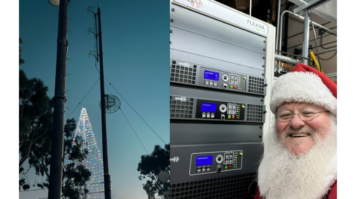CHICAGO — If longevity and dedication to a single employer are measuring sticks in a career, Gordon Carter is off the yardstick.
Carter, 64, retired as chief engineer after 41 years with WFMT(FM) in Chicago at the end of July.

WFMT CE Gordon Carter The veteran broadcast engineer witnessed the technological evolution in radio broadcasting from analog to digital through more than four decades at WFMT, known in the industry for its excellent audio fidelity.
Carter even played a role in the dawning of the digital media era when Sony chose WFMT, a non-commercial classical music and fine arts station, to be the first radio station in the world to broadcast a compact disc recording in 1982.
Sony released the first CD player, the CDP-101, earlier that year.
“We’d always had a very good relationship with Sony over the years. They told us they had this new format to debut and I think they figured they had better do it on a station that sounded good,” Carter said.
“They arrived that day with the player in an attaché case and a disc. We talked about it on the air. It was really an event.”
Carter recalled that Sony later used WFMT for the on-air debut for Digital Audio Tape (DAT) in 1987 and the MiniDisc in 1992.
How fussy was Carter and the other WFMT broadcast engineers about FM audio quality? He said at one time he designed and built his own audio routing switchers for the station because nothing on the market was good enough.
“It has always been my view that the secret of good audio is simply good engineering practices. A station can sound good on a shoestring budget if the equipment is properly chosen and maintained.”
Carter, who started at WFMT as a staff engineer in 1969, has authored a number of articles about FM audio and processing and given numerous industry presentations on the topics. He’ll moderate multiple sessions at the Broadcasters Clinic in Madison, Wis., this fall.
“Processing is only part of the total audio chain. I always paid attention to all aspects of the audio chain. Remember that your total sound will be no better than your worst piece of equipment in the chain, but good quality does not have to cost a lot.”

Gordon Carter works on a VCR at WFMT in downtown Chicago about 1985. The station used Beta VCRs with the PCM-F1 Digital Recording Processor to record digital audio on videotape. The device took analog audio inputs, converted it to the EIAJ 14-bit PCM digital format, and then converted it to a video signal. WFMT, licensed to Window to the World Communications, has studios in northwest Chicago and its HD Radio transmitter and antenna atop the Willis Tower, formerly the Sears Tower, downtown. The radio station has never changed from its classical music format since it signed on in 1951.
Window to the World, formerly known as Chicago Educational Television Association, also is licensee of WTTW(TV) in Chicago.
No replacement for Carter had been named by late July.
An AM beginning
Carter was born and raised in Pottstown, Pa., which is approximately a half-hour northwest of Philadelphia. He majored in missionary radio at Moody Bible Institute in Chicago and after graduation spent three months in Aruba helping to erect a new AM tower.
Soon after returning stateside, Carter was hired by Great Scott Broadcasting to do studio and transmitter maintenance at WTTM(AM) in Trenton N.J.
“Try doing this today: I walked into the local station in Pottstown and asked to speak to the owner. That was Herb Scott. I asked him for a job and 20 minutes later he hired me for his Trenton radio station.”
In 1969, Carter made the move to Chicago and WFMT. He worked under the tutelage of Chief Engineer Alfred Antlitz, who allowed Carter to explore new technologies as part of his job.
Carter was involved in three studio and three transmitter moves through the years, including a transmitter move from the John Hancock Center to the Sears Tower in 2000. He worked as a studio supervisor and telecommunications manager at WFMT before being named chief engineer in 1995, a title that included computer network administration duties, in addition to RF work.
Carter said he has spent much of the past few years sitting at a keyboard, monitoring systems; but it wasn’t always that way. WFMT had an engineering staff of three — Antlitz, Frank Teller and himself — when Carter started. Now that staff consists of Carter and a union TV transmitter supervisor, who works on the WFMT HD transmitter under Carter’s supervision.
“Since the staff has been pared down we don’t have time to design things or fix things. We would build equipment in our back room. That was a lot of fun. Of course along terms of repair, with the advent of surface-mount [technology] and digital, most of what we deal with is not repairable to the component level today. But anymore, we just swap boards,” Carter said. “That’s very different from the way we used to think.”

Carter at a WFMT console sometime before 1981. Transmitters are vastly different, too, Carter said. When he started, it was the sight of all those tubes that excited him about getting into broadcast engineering.
“Now you look into a cabinet and you see a lot of Cat-5 wire. We are still making RF, but it is vastly different. Today, with our solid-state transmitter, I get e-mails from Nautel telling me there is a firmware update I need to download,” Carter said. “Now I can monitor every module in the transmitter and what it is doing from my home.”
WFMT began transmitting an HD Radio signal in 2009 when it purchased a Nautel NV-40 FM transmitter. Carter, who has high hopes for HD Radio’s multicasting capabilities, said he suggested some engineering improvements to the transmitter that Nautel subsequently incorporated into its NV-40.
Carter, who also was responsible for administration of WFMT’s Prophet NexGen audio system, said he plans to do a bit of engineering consulting in retirement and spend more time pursuing his interest in trains — both real and model. Of particular interest to him is the history of the Reading Railroad, which ran from Reading, Pa., to Philadelphia and through his hometown of Pottstown.
He has been married to his wife Sharon for 42 years. The couple lives in La Grange, Ill., and has two adult children.
He said he has always had the ability to learn on his own, which has served him well working in a profession that can see technology change quickly.
“Most of what I learned in school has been long forgotten or become obsolete. Pretty much everything I know about broadcast technology today I learned on my own. A person has to be willing to keep learning. I’ve known people who refused to change and they were left behind by the industry.”







